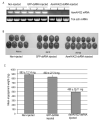Deorphanization and target validation of cross-tick species conserved novel Amblyomma americanum tick saliva protein
- PMID: 23428900
- PMCID: PMC4058329
- DOI: 10.1016/j.ijpara.2012.12.012
Deorphanization and target validation of cross-tick species conserved novel Amblyomma americanum tick saliva protein
Abstract
We previously identified a cross-tick species conserved tick feeding stimuli responsive Amblyomma americanum (Aam) AV422 gene. This study demonstrates that AamAV422 belongs to a novel group of arthropod proteins that is characterized by 14 cysteine amino acid residues: C(23)-X7/9-C(33)-X23/24-C(58)-X8-C(67)-X7-C(75)-X23-C(99)-X15-C(115)-X10-C(126)-X24/25/33-C(150)C(151)-X7-C(159)-X8-C(168)-X23/24-C(192)-X9/10-C(202) predicted to form seven disulfide bonds. We show that AamAV422 protein is a ubiquitously expressed protein that is injected into the host within the first 24h of the tick attaching onto the host as revealed by Western blotting analyses of recombinant (r)AamAV422, tick saliva and dissected tick organ protein extracts using antibodies to 24 and 48 h tick saliva proteins. Native AamAV422 is apparently involved with mediating tick anti-hemostasis and anti-complement functions in that rAamAV422 delayed plasma clotting time in a dose responsive manner by up to ≈ 160 s, prevented platelet aggregation by up to ≈ 16% and caused ≈ 24% reduction in production of terminal complement complexes. Target validation analysis revealed that rAamAV422 is a potential candidate for a cocktail or multivalent tick vaccine preparation in that RNA interference (RNAi)-mediated silencing of AamAV422 mRNA caused a statistically significant (≈ 44%) reduction in tick engorgement weights, which is proxy for amounts of ingested blood. We speculate that AamAV422 is a potential target antigen for development of the highly desired universal tick vaccine in that consistent with high conservation among ticks, antibodies to 24h Ixodes scapularis tick saliva proteins specifically bound rAamAV422. We discuss data in this study in the context of advancing the biology of tick feeding physiology and discovery of potential target antigens for tick vaccine development.
Copyright © 2013 Australian Society for Parasitology Inc. Published by Elsevier Ltd. All rights reserved.
Figures










Similar articles
-
Amblyomma americanum (L.) (Acari: Ixodidae) tick salivary gland serine protease inhibitor (serpin) 6 is secreted into tick saliva during tick feeding.J Exp Biol. 2011 Feb 15;214(Pt 4):665-73. doi: 10.1242/jeb.052076. J Exp Biol. 2011. PMID: 21270316 Free PMC article.
-
Tick-Host Range Adaptation: Changes in Protein Profiles in Unfed Adult Ixodes scapularis and Amblyomma americanum Saliva Stimulated to Feed on Different Hosts.Front Cell Infect Microbiol. 2017 Dec 19;7:517. doi: 10.3389/fcimb.2017.00517. eCollection 2017. Front Cell Infect Microbiol. 2017. PMID: 29312895 Free PMC article.
-
Time-resolved proteomic profile of Amblyomma americanum tick saliva during feeding.PLoS Negl Trop Dis. 2020 Feb 12;14(2):e0007758. doi: 10.1371/journal.pntd.0007758. eCollection 2020 Feb. PLoS Negl Trop Dis. 2020. PMID: 32049966 Free PMC article.
-
Dual silencing of long and short Amblyomma americanum acidic chitinase forms weakens the tick cement cone stability.J Exp Biol. 2014 Oct 1;217(Pt 19):3493-503. doi: 10.1242/jeb.107979. Epub 2014 Sep 4. J Exp Biol. 2014. PMID: 25189365 Free PMC article.
-
Binding Molecules in Tick Saliva for Targeting Host Cytokines, Chemokines, and Beyond.Biomolecules. 2024 Dec 21;14(12):1647. doi: 10.3390/biom14121647. Biomolecules. 2024. PMID: 39766354 Free PMC article. Review.
Cited by
-
Identification of four novel Rhipicephalus annulatus upregulated salivary gland proteins as candidate vaccines.Protein J. 2013 Jun;32(5):392-8. doi: 10.1007/s10930-013-9498-x. Protein J. 2013. PMID: 23775170
-
Identification and characterization of proteins in the Amblyomma americanum tick cement cone.Int J Parasitol. 2018 Mar;48(3-4):211-224. doi: 10.1016/j.ijpara.2017.08.018. Epub 2017 Dec 16. Int J Parasitol. 2018. PMID: 29258831 Free PMC article.
-
Saliva of Rhipicephalus (Boophilus) microplus (Acari: Ixodidae) inhibits classical and alternative complement pathways.Parasit Vectors. 2016 Aug 11;9(1):445. doi: 10.1186/s13071-016-1726-8. Parasit Vectors. 2016. PMID: 27515662 Free PMC article.
-
Amblyomma americanum tick saliva insulin-like growth factor binding protein-related protein 1 binds insulin but not insulin-like growth factors.Insect Mol Biol. 2015 Oct;24(5):539-50. doi: 10.1111/imb.12180. Epub 2015 Jun 25. Insect Mol Biol. 2015. PMID: 26108887 Free PMC article.
-
Disruption of blood meal-responsive serpins prevents Ixodes scapularis from feeding to repletion.Ticks Tick Borne Dis. 2018 Mar;9(3):506-518. doi: 10.1016/j.ttbdis.2018.01.001. Epub 2018 Jan 10. Ticks Tick Borne Dis. 2018. PMID: 29396196 Free PMC article.
References
-
- Alarcon-Chaidez F, Ryan R, Wikel S, Dardick K, Lawler C, Foppa IM, Tomas P, Cushman A, Hsieh A, Spielman A, Bouchard KR, Dias F, Aslanzadeh J, Krause PJ. Confirmation of tick bite by detection of antibody to Ixodes calreticulin salivary protein. Clin. Vaccine Immunol. 2006;13:1217–1222. - PMC - PubMed
-
- Anderson RB, Scrimgeour GJ, Reuben K. Responses of the ixodid tick, Amblyomma hebraeum (Acari: Ixodidae), to carbon dioxide. Exp. Appl. Acarol. 1998;22:667–681.
Publication types
MeSH terms
Substances
Associated data
- Actions
Grants and funding
LinkOut - more resources
Full Text Sources
Other Literature Sources

